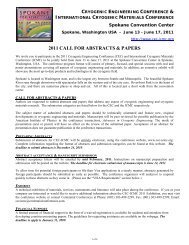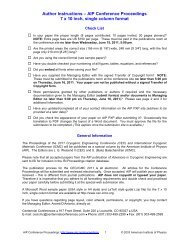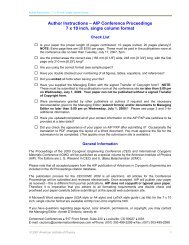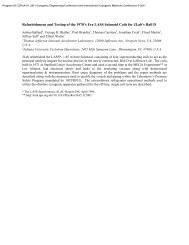CEC Abstracts in PDF format (as of 7/3/07) - CEC-ICMC 2013
CEC Abstracts in PDF format (as of 7/3/07) - CEC-ICMC 2013
CEC Abstracts in PDF format (as of 7/3/07) - CEC-ICMC 2013
Create successful ePaper yourself
Turn your PDF publications into a flip-book with our unique Google optimized e-Paper software.
<strong>CEC</strong> 20<strong>07</strong> - <strong>Abstracts</strong><br />
C2-E-02 Hybrid Regenerator for Compact Stirl<strong>in</strong>g<br />
Cryocooler Design <strong>as</strong>pectes <strong>of</strong> a compact hybrid<br />
regenerator for pulse tube cryocooler application<br />
B.T. Kuzhiveli, National Inst. <strong>of</strong> Technology Calicut.<br />
A study h<strong>as</strong> been conducted to f<strong>in</strong>d out the optimum configuration <strong>of</strong><br />
regenerators to be used for m<strong>in</strong>iature cryocoolers. Mesh sizes start<strong>in</strong>g<br />
with 200 up to 400 with an <strong>in</strong>terval <strong>of</strong> 50 have been sampled and<br />
performance estimation h<strong>as</strong> been made. The study h<strong>as</strong> been extended<br />
to determ<strong>in</strong>e the performance <strong>of</strong> a hybrid regenerator and its<br />
suitability to use <strong>in</strong> a cryocooler which can produce 5W at 80 K. A<br />
methodology h<strong>as</strong> been developed to arrive at the appropriate mesh<br />
size and number <strong>of</strong> mesh to be used <strong>in</strong> the hybrid regenerator to go<br />
hand <strong>in</strong> hand with the available m<strong>as</strong>s. Results are presented <strong>in</strong> the<br />
form <strong>of</strong> design charts for quick reference which could be helpful <strong>in</strong><br />
the design <strong>of</strong> m<strong>in</strong>iature regenerators.<br />
C2-E-03 Dynamic characteristics <strong>of</strong> oscillat<strong>in</strong>g flow<br />
regenerators<br />
H.L. Chen, L.W. Yang, J.H. Cai, J.T. Liang, Y. Zhou,<br />
Technical Institute <strong>of</strong> Physics and Chemistry, CAS.<br />
Regenerator is the most important component <strong>in</strong> a pulse-tube<br />
cryocooler. Because <strong>of</strong> oscillat<strong>in</strong>g flow, heat transfer and flow<br />
resistance <strong>in</strong> the regenerator are complex, and ph<strong>as</strong>e shifts between<br />
parameters affect the cool<strong>in</strong>g performance evidently. Regenerator<br />
research is a fundamental work for cryocoolers. Experiments are<br />
performed to test regenerators <strong>of</strong> different size filled with different<br />
mesh number screens. Two f<strong>in</strong>e hot-wire anemometers are used to<br />
me<strong>as</strong>ure the <strong>in</strong>stantaneous velocities at the <strong>in</strong>let and outlet <strong>of</strong> the<br />
regenerators, and the pressure waves are me<strong>as</strong>ured by piezoelectric<br />
pressure transducers at the same positions. The respond<strong>in</strong>g frequency<br />
<strong>of</strong> the me<strong>as</strong>ur<strong>in</strong>g system is high enough.<br />
In the p<strong>as</strong>t, we have performed experiments to study the oscillat<strong>in</strong>g<br />
flow at around 50Hz.In this paper, the system is driven by a<br />
thermoacoustic eng<strong>in</strong>e which generates a pressure wave at 300Hz.<br />
The two k<strong>in</strong>ds <strong>of</strong> results are compared and analyzed.<br />
C2-E-04 Analysis <strong>of</strong> Cryogenic Regenerator for Magnetic<br />
Refrigerator Applications<br />
B.T. Kuzhiveli, National Institute <strong>of</strong> Technology<br />
Calicut; R. Chah<strong>in</strong>e, T.K Bose, Institut de recherche<br />
sur l’hydrogène, Université du Québec; C.B. Zimm,<br />
Astronautics Corporation <strong>of</strong> America.<br />
Magnetic refrigeration uses the temperature and field dependence <strong>of</strong><br />
the entropy <strong>of</strong> specific magnetic materials to accomplish cool<strong>in</strong>g.<br />
Because <strong>of</strong> the high efficiency <strong>of</strong> the magnetization and<br />
demagnetization processes and also because <strong>of</strong> the potential for<br />
excellent heat transfer between solid magnetic material and fluids,<br />
magnetic refrigerators may promise to have higher efficiency than<br />
exist<strong>in</strong>g g<strong>as</strong> cycle refrigerators. Many ground b<strong>as</strong>ed and space borne<br />
applications could benefit significantly from the cost sav<strong>in</strong>gs implied<br />
by efficiency. This paper deals with a b<strong>as</strong>ic computational model<br />
which could predict the temperature drop caused by the regenerator<br />
effect. It solves partial differential equations that describe fluid flow<br />
comb<strong>in</strong>ed with heat transfer between fluid and solid regenerator<br />
particles. Temperature changes are calculated for discrete material<br />
segments at a number <strong>of</strong> time <strong>in</strong>tervals over a complete operation<br />
cycle. A numerical step-by-step procedure to solve the differential<br />
equations describ<strong>in</strong>g the regenerative heat exchanger is set out and a<br />
computer program h<strong>as</strong> been made to predict performance <strong>of</strong> the<br />
regenerator.<br />
C2-E-05 Second-Law Analysis and Optimization <strong>of</strong><br />
Regenerators Us<strong>in</strong>g REGEN 3.2<br />
A.J. Lopez, The Univ. <strong>of</strong> Nex Mexcio; Sandia Nat`l<br />
Laboratories; C. Dodson, A. Razani, The Univ. <strong>of</strong> New<br />
Mexico; Air Force Research Lab..<br />
In most Stirl<strong>in</strong>g and pulse tube refrigerators the regenerative heat<br />
exchanger is the major contributor to the irreversibility <strong>of</strong> the<br />
refrigerators. Exergy analysis is a convenient method to quantify the<br />
losses <strong>in</strong> regenerators. NIST Code REGEN 3.2 provides a powerful<br />
tool to quantify exergy flow <strong>in</strong> the regenerators to evaluate the exergy<br />
destruction (irreversibility) due to heat transfer and fluid friction. The<br />
effect <strong>of</strong> important parameters, with emph<strong>as</strong>is on the ph<strong>as</strong>e shift<br />
between the pressure and the m<strong>as</strong>s flow rate at the cold side <strong>of</strong><br />
regenerator, on the exergetic efficiency and the important components<br />
<strong>of</strong> exergy destruction <strong>in</strong> the regenerator is presented. The efficiency<br />
<strong>of</strong> the regenerator b<strong>as</strong>ed on exergy analysis is compared to other<br />
methods <strong>of</strong> evaluat<strong>in</strong>g regenerator performance. The ability <strong>of</strong> the<br />
code to quantify the exergy flow and destruction at low temperatures<br />
where the ideal g<strong>as</strong> <strong>as</strong>sumption is not applicable is discussed.<br />
C2-E-06 Longitud<strong>in</strong>al Hydraulic Resistance Parameters<br />
<strong>of</strong> Cryocooler and Stirl<strong>in</strong>g Regenerators <strong>in</strong> Steady Flow<br />
W.M. Clearman, S.M. Ghia<strong>as</strong>iaan, P.V. Desai, G.W.<br />
Woodruff School <strong>of</strong> Mechanical Eng<strong>in</strong>eer<strong>in</strong>g Georgia<br />
Institute <strong>of</strong> Technology.<br />
The results <strong>of</strong> an ongo<strong>in</strong>g research program aimed at the me<strong>as</strong>urement<br />
and correlation <strong>of</strong> anisotropic hydrodynamic parameters <strong>of</strong> widelyused<br />
cryocooler regenerator fillers are presented. The hydrodynamic<br />
parameters <strong>as</strong>sociated with steady, longitud<strong>in</strong>al flow are addressed <strong>in</strong><br />
this paper. An experimental apparatus consist<strong>in</strong>g <strong>of</strong> a cyl<strong>in</strong>drical test<br />
section packed with regenerator fillers is used for the me<strong>as</strong>urement <strong>of</strong><br />
axial permeability and Forchheimer coefficients, with pure helium <strong>as</strong><br />
the work<strong>in</strong>g fluid. The regenerator fillers that are tested <strong>in</strong>clude<br />
sta<strong>in</strong>less steel 400-mesh screens with 69.2% and 62% porosity,<br />
sta<strong>in</strong>less steel 325-mesh screens with 69.2% and 62% porosity,<br />
sta<strong>in</strong>less steel 400-mesh s<strong>in</strong>tered filler with 62% porosity, and<br />
sta<strong>in</strong>less steel s<strong>in</strong>tered foam metal with 56% porosity. The test section<br />
is subjected to a steady flow <strong>of</strong> helium at one end, and is open to the<br />
atmosphere at the other end. The <strong>in</strong>strumentation <strong>in</strong>cludes pressure<br />
transducers and a high-precision flow meter. For each filler material,<br />
time histories <strong>of</strong> local pressures at <strong>in</strong>let to the regenerator are<br />
me<strong>as</strong>ured under steady flow conditions over a wide range <strong>of</strong> flow<br />
rates. A CFD <strong>as</strong>sisted methodology is then used for the analysis and<br />
<strong>in</strong>terpretation <strong>of</strong> the me<strong>as</strong>ured data. The permeability and<br />
Forchheimer parameter values obta<strong>in</strong>ed <strong>in</strong> this way are then correlated<br />
<strong>in</strong> terms <strong>of</strong> the relevant dimensionless parameters.<br />
Page 24 <strong>of</strong> 53






